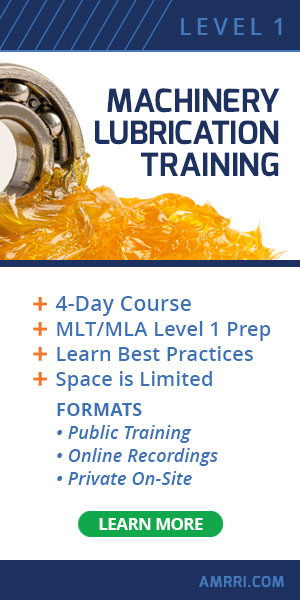Implementing reliability solutions involves solving problems and deciding how to effectively use oil sample test data as a fundamental building block to drive program success. Many decisions confront the end user when they perform their own oil testing and analysis.
This article provides seven elements to consider when going through the process of bringing oil analysis onsite. After reviewing these elements, the end-user may find it makes sense to shift all the current routine oil analysis tests in-house or use a hybrid approach and only do some testing onsite while maintaining a relationship with a third-party lab.
Criticality Profile
The first step in this process is to build a list or scope of machinery to test and monitor. Several standard methods have been published to help the end user with this review. The use of ASTM 7874 Standard Guide for Applying Failure Mode and Effect Analysis (FMEA) to In-Service Lubricant Testing and ASTM D6224 Standard Practice for In-Service Monitoring of Lubricating Oil for Auxiliary Power Plant Equipment are two of these.
Both standards are based upon the concepts of Failure Modes Effects and Criticality Approach (FMECA) and allow the end-user to systematically enter into a process to select the most critical components to sample and trend. This approach is useful to help zero in on a self-run monitoring program. Some may see this as an advanced approach.
Other strategies are also available to build a strong program. A helpful starting point is to review past work history to determine what equipment failed and why the failures occurred. The cost burden from the equipment failure to the facility or process should be considered.
Some simple questions should always be in focus when doing this review, such as: Were the failures linked to the lubricant, machine design, or maintenance practice?
Also remember to review the oil testing that could be done and then determine how those tests could have helped manage the cause of the failure or failure mode.
Whichever path is used to define the program’s scope, the reliability professional should keep in mind that the main goals of developing machinery criticality profiles include safety risk, uptime, productivity, and repair expense.
Sampling Frequency
A common mistake when building a lubricant condition monitoring program is taking samples too often or, more commonly, not enough. There are several ways to make this determination.
One approach is to consult OEM documentation. These may come from OEM technical bulletins or manuals or relate to warranty recommendations for the component. The oil manufacturer may provide additional perspective for their products.
The partnership with a third-party testing laboratory may also produce further insight. It’s common for testing programs to begin with a third-party testing service, so sampling intervals may have been previously established.
ASTM standards D4378 Standard Practice for In-Service Monitoring of Mineral Turbine Oils for Steam, Gas, and Combined Cycle Turbines and ASTM D6224 also provide sample interval recommendations. ASTM D7874 may be used to refine any sampling interval obtained from the named strategies, as the interval would then be based on the FMEA analysis.
Developing a Sample Test Slate and Alarm Limits
There are several books and references available that can help with general guidelines for developing a sample test slate for compressors, turbines, engines, hydraulic systems, etc. ASTM D6224 is one such example, as it provides general guidance for broad classes of machinery. AMETEK Spectro Scientific’s TruVu360 software is another source that can also help with this process.
With 31 different component types available, the user can select from a series of components programmed into the software, such as steam turbine, gas turbine, hydraulic unit, etc., and receive guidance from the software as to which tests should be run and the recommended alarm limits and diagnostics associated with the component.
Designing Your Optimal Onsite Lab
When designing an onsite lab, there are several things to consider:
- Budget
- Space available
- Chemicals needed (if any) and sample disposal volumes (if any)
- Manpower available
- Training requirements
- Turnaround time requirements
- Data needed and the organization’s Key Performance Indicators (KPIs)
“Data needed” should be considered when building the onsite lab; however, budget, space, and manpower often drive this decision. These things can become limitations or opportunities to flourish but should be considered strongly before bringing a program onsite.
One big “win” or catch of a catastrophic failure could easily allow a budget to increase year-to-year.
It’s essential to trend the “wins” within the program as its budget can quickly change with justification. Training is much more important than many believe, as data accuracy directly impacts the quality of the analysis and repair recommendations. Of course, knowing what the data means and represents can easily make or break a program.
Lubricant Storage
New lubricant testing and storage effectiveness should be part of all lubricant testing programs. Having an onsite laboratory increases the likelihood that new lubricant testing is part of the monitoring strategy, as it isn’t intuitive to many why new oil needs to be tested. Proper lubricant storage and dispensing should be an easy win and is more important than many realize.
New lubricant testing is the first line of defense to ensure the correct lubricant is used and that clean lubricants are going into service. If new lubricant testing is not part of the condition monitoring program, stop and get this in order. There is no point in placing oil into service that is not correctly stored or managed.
Plenty of evidence in open literature shows that one of the leading causes of bearing failures occurs because of dirty oil; therefore, the lack of a new oil testing practice has a direct relationship to the overall maintenance cost. The lube room should have smart inventory practices to maximize the life of the oil, properly filter and test new oil and optimize temperature control.
Training
On-the-job training has merit when highly knowledgeable reliability professionals are available to help new personnel gain fundamental program knowledge. Poor recommendations can ensue when basic testing or data interpretation knowledge is unavailable. Whether someone is an engineer, mechanic, lab tech, chemist, etc., the chances that they have received any oil analysis-specific training earlier in their formalized education is very slim.
It is highly suggested that all individuals responsible for making maintenance decisions based on lubricant analysis data receive formalized training which should be certified through an independent body or society. Several organizations can provide the proper training to work in an oil analysis lab and understand the data generated from the lab equipment.
The International Council for Machinery Lubrication (ICML) and Society for Tribologists and Lubrication Engineers (STLE) offer oil analysis courses that help achieve these goals. Most end-users will find ICML’s MLA I class or STLE’s OMA I class are optimal for their onsite needs.
To get a positive return on investment, an organization will need the initial outlay for onsite lab equipment to pay off. Understanding what the test data means is vital, as that knowledge can be applied to increase machinery uptime and predict developing component failures.
Software
Currently, software overload can be a real thing. Consider the organization’s needs before searching for a Maintenance Monitoring System. Consider things like organizational KPIs, work order needs, and data storage requirements from different sources of the program (i.e., vibration and lube data in one place).
The software selection must help the organization easily track and highlight the “wins” within the condition monitoring program.
Here are a few simple questions to bring it all together and sustain your program. The site’s lubrication champion should drive these questions:
- What plant equipment is critical to our process?
- How often do we need to sample to be able to find problems?
- What lab test(s) will give us the most useful data (i.e., ROI)?
- Is it practical to run an in-house testing program?
- Is our lube room storage practice improving our oil integrity?
- What training does my team need, and how often?
- Which software can track data, work orders, and KPIs effectively?
Working through these questions collectively with the maintenance team and aligning with the organization’s overall goals can ensure the long-standing success of the onsite oil analysis program. For more information about setting up your onsite oil analysis program, visit AMETEK Spectro Scientific’s website https://www.spectrosci.com/ or contact Lisa Williams at lisa.williams@ametek.com.
References and Acknowledgements:
https://www.astm.org/d6224-16.html
https://www.astm.org/d7874-13r22.html
https://www.astm.org/d4378-20.html
https://www.icmlonline.com/exams/Default.aspx?p=MLA1
OMA – Certified Oil Monitoring Analyst I – STLE
Special thanks to Bryan Johnson for his thoughts and insights in developing this article.










